Research 
Current Projects
The main goal of my research is to understand how galaxies and AGN evolve,
with a particular focus on the interplay with the properties of their
environment. You can see me one of my older talks about these topics
here. Here's a list of
my publications.
At ESO, I was involved in organising the weekly Galaxy Cluster Discussion Group
and the monthly Wine & Cheese seminar. I was also the main organiser (
with Tony Mroczkowski) of the
Early Stages of Cluster formation conference, that happend in July 2017, at the ESO headquarters.
What I am currently working on
I am currently leading a major project in analysing the star forming properties of a sample of galaxy clusters, spanning a range is mass, merger state and redshift.
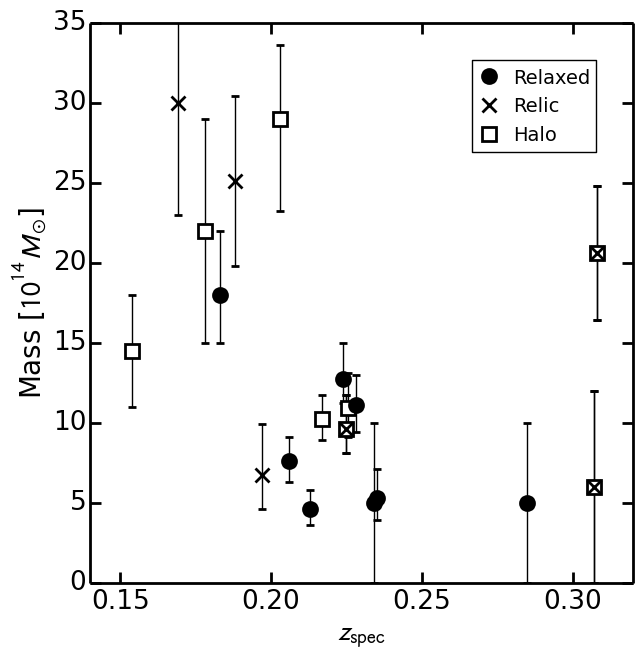
The sample of merging and relaxed clusers we are studying.
Our first paper from the series presents the sample of ~20 relaxed and merging clusters. We find that Hα emitting star forming galaxies are way more common in disturbed clusters in formation compared to relaxed clusters. Among disturbed large scale hosts, clusters hosting large-scale shock waves are overdense in star forming galaxies compared to those with turbulence in their intra-cluster medium. We speculate that the increase in star formation activity in disturbed, young, massive galaxy clusters can be triggered by interactions between gas-rich galaxies, shocks and/or the intra-cluster medium, as well as accretion of filaments and galaxy groups. Our results indicate that disturbed clusters represent vastly different environments for galaxy evolution compared to relaxed clusters or average field environments.
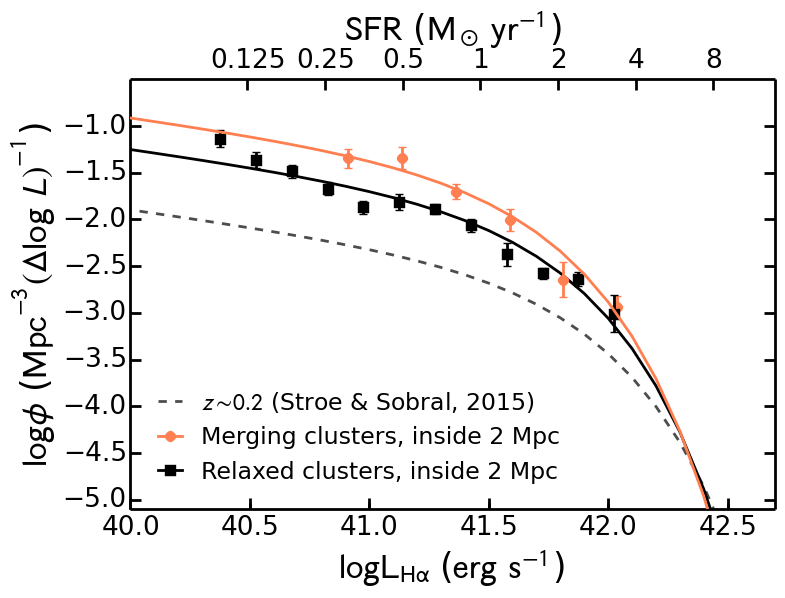
Hα luminosity function. Merging cluster have a higher density of star forming, Hα emitting galaxies than relaxed clusters, at all luminosities and star formation rates.
Hα observations of merging clusters
We investigated the role of merger shocks in shaping the Hα luminosity function in galaxies within disturbed clusters. We discovered extended Hα haloes in galaxies neighbouring the relics in Sausage cluster, which were possibly disrupted by the passage of the shock wave. Our results suggest that cluster mergers may play an important role in the evolution of cluster galaxies through shock-induced star formation. This effect depends on time since core passage for the subclusters and one would only see an enhancement in star formation in a recent merger. You can find the papers here and here. These galaxies also posses copious amounts of neutral gas to feed the high rate of star-formation (see paper). The passage of the shock through a galaxy is not only reflected in the star-formation rate, but also through an increased supernova rate, high outflows and increased metallicity and very low electron densities (see paper).
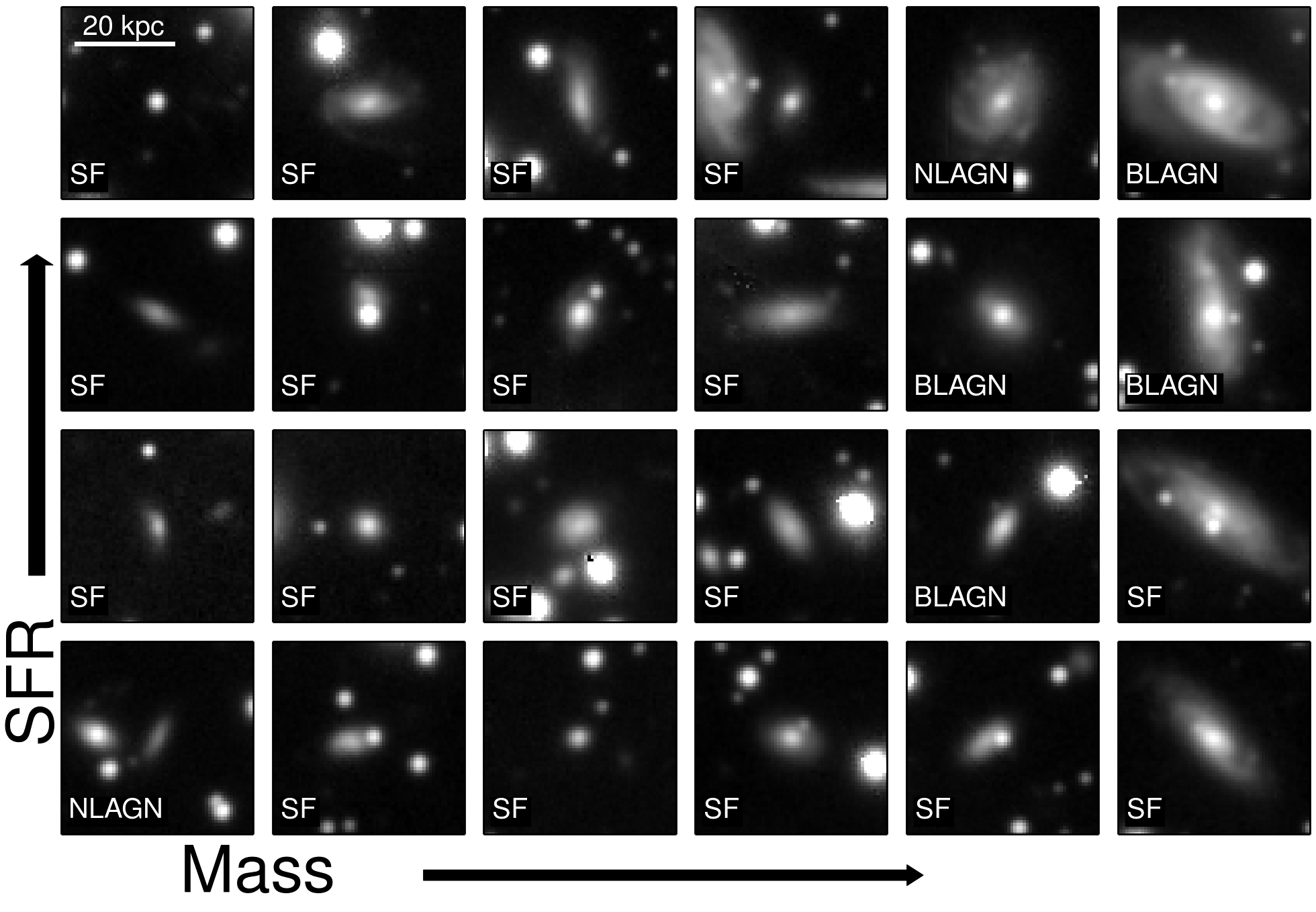
Morphologies of Hα emitting star forming galaxies in the massive, merging 'Sausage' cluster.
Spectral modelling of radio relics
By using the BRATS spectral modelling software, we fitted spectral ageing models to some of the best radio datasets available for a radio relic -- the northern relic in the Sausage cluster. Our results indicate Mach numbers which are consistent with the X-ray derived Mach number (inconsistency which has been an issue in the field for a few years now). We could determine the shock advance speed and place constraints on the core passage of this merging cluster at 0.6 - 0.8 Gyr ago. We find a systematic electron age across the relic, indicating the shock front in moving northwards at constant rate. You can find the paper here.
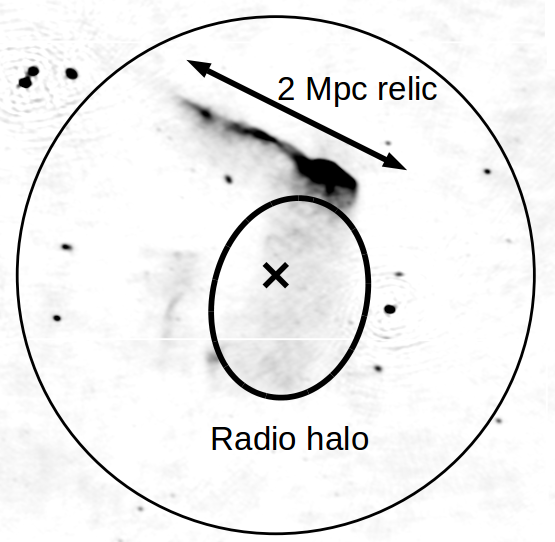
The distrubed, merging galaxy cluster named the 'Toothbrush'.
Very high-frequency radio observations of merging clusters
With the aid of the AMI telescope, we have made a surprising, very high frequency detection of a cluster radio relic. The results indicates that our currently-accepted, simple view of radio relic formation needs improving. You can find the paper here. More recently, we have detections at a whooping 30 GHz, confirming our previous results (see paper ). Our models indicate that an evolving magnetic field behind the shock wave can explain the steepening observed (paper).
Low-frequency radio observations of merging clusters
My first PhD project dealt with a low radio frequency analysis of the cluster nicknamed the "Sausage", in which we pinpoint the electron injection and acceleration mechanisms operating in the diffuse radio emission. A high-resolution version of this paper can be found here.
Projects I am contributing to
I have majorly contributed to a number of projects aimed at furthering our understanding of the merging clusters, specifically the `Sausage' and `Toothbrush' clusters, which host double radio relics.
- Weak lensing analysis of the clusters (see paper and paper).
- Redshift/dynamical analysis of the clusters (paper).
- Radio and/or suzaku observations of the cluster environment (paper and paper).
- Discovery of steep spectrum emission in A2034 (paper).
- Discovery of a high redshift mini-halo (paper).
I am also involved in studies of the coevolution of galaxies, AGN and their environment:
- Ly emitters at mid redshift (see paper).
- Evolution of star forming galaxies in their large scale environment (see paper).
- More dusty galaxies in clusters (see paper).
I am involved in radio sky surveys and radio techniques:
- LOFAR facet calibration (see paper).
- LOFAR Two-metre Sky Survey(see paper).
- LOFAR MSSS survey (see paper).
Past Projects
Clusters with VISTA
My Master's thesis (under Dr. Manda Banerji) was concerned with deriving physical properties of two galaxy clusters discovered by the South Pole Telescope through the Sunyaev-Zel’dovich effect (SZE), by using coordinated optical and infra-red data. For cluster SPT-CL J0528-5259, at redshift 0.75, the positions of the members are yet unknown. Two sets of coordinates have been reported for this cluster: one location of the brightest cluster galaxy, derived from a spectroscopic analysis, and the second from SZE measurements. By investigating all the objects within 2 arcmin of the position of the brightest cluster galaxy, I found a clear overdensity of galaxies at the expected redshift and prove that this is the correct cluster location. I also obtain a rich red sequence of bright, massive elliptical galaxies in two colour - magnitude plots. By contrast, 21 members of SPT-CL J0546-5345 at z = 1.06 have been spectroscopically confirmed. For the 9 galaxies recovered in the infra-red data, I produced photometric redshifts matching spectroscopic measurements. I performed a test of various combinations of magnitude apertures, filters and galaxy models to establish that the best photometric redshifts are obtained when fitting both optical and infra-red fluxes, using Petrosian magnitudes, to templates for all galactic types. I derived the first stellar mass estimates for the members of this cluster and obtain consistent light to mass ratios. The investigation concluded that the best and most reasonable fits are obtained when the masses are derived from coordinated optical and infra-red filters and fixing all the galaxies as ellipticals.
Radial Velocities
During my summer studentship at the IoA in 2011, I worked with Prof Roger Griffin on a long-term observing programme of radial velocities of a set of ~80 seventh-magnitude late-type stars. Some of them proved to be spectroscopic binaries with exceptionally long periods, of the order of decades.
Optical Interferometry
This project started as my internship during the summer of 2009 within the Optical Interferometry group at MRAO. I first designed a virtual observatory to simulate observations that would be made with the upcoming Magdalena Ridge Observatory Interferometer. Upon its completion this will be the largest, most powerful optical interferometer in the world with up to 10 telescopes working in concert to obtain a resolution better than 1 mas. I used this programme for my Bachelor thesis in Astrophysics, where I investigated the capabilities to reconstruct the true morphology of a star + gas + dust ring system with an MROI-type of telescope.
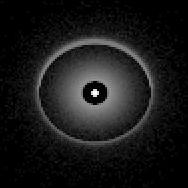
The real "looks" of the star
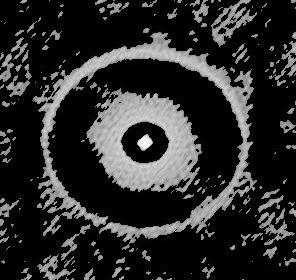
Reconstruction with a ten-element interferometer
Magnetotail of the Earth
The topic of Physics Bachelor thesis, was also conceived during a summer internship on space plasma(2009, at MPE). My project was concerned with analyses on the processes occurring in the plasma sheet in the magnetosphere of the Earth, using Cluster mission data, a four-spacecraft mission. I used the three-point gradient estimation scheme to finding evidence of local magnetohydrostatic equilibria in the Earth’s magnetotail which are characterized by a balance of the pressure gradient and the Lorentz force. This particular method needs to be employed because, in the case of the pressure, the measurement instrument does not work on all Cluster spacecraft and it is impossible to discriminate between spatial and temporal variations.
Collaborators







